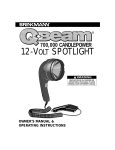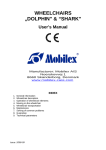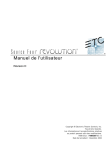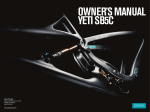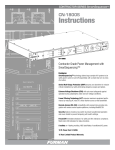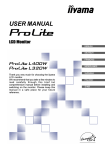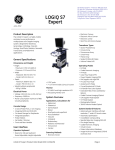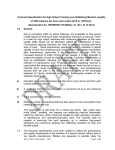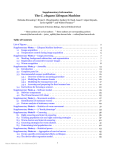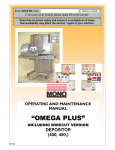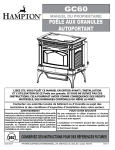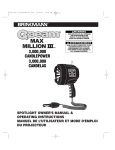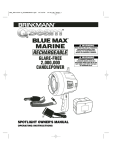Download User Manual - Main Light Industries
Transcript
User Manual Revision D C o p y r i g h t © E le c tr o n i c T h e a t r e C o n t r o l s , I n c . All Rights reserved. P r o d u c t in f o r m a t i on a n d s p e c i f i c a t i o n s s u bj e c t t o c h a n g e . P a r t N u m b e r : 7160M1200 R e v D Released: November 2004 A C C R E D I T A T I O N S A N D R E C O G N I T I O N S ( f r o m E T L S E M K O : w w w .u s a . e t l s e m k o . c o m) E T L S E M K O i s r e c o g n i z e d b y O S H A i n t h e U . S . a s a N a t i o n a l l y R e c o g n i z e d T e s ti n g L a b o r a to r y . E T L t e s t s t o s t a nd a r d s d e v e l o p e d or a p p r o v e d b y t h e A m e r i c a n N a t i o n a l S t a n d a r d s I n s t i tu t e ( A N S I ) , U n d e r w r i t e rs L a b o r a t o r i e s ( U L ) a n d o t h e r s . O t h e r n o t a b l e a c c r e d i t a t i o n s i n c l u d e t h e A m e r i c a n A s s o c i a t i o n o f L a b o r at o r i e s A c c r e d i t a ti o n s ( A 2 L A ) , A m e r i c a n N a t i o n a l S t a n d a r d s I n s t i t u t e ( A N S T ) , I n t e r n at i o n a l C o n f e r e nc e o f B u il d i n g O f f i c i a l s ( I C B O ) , a n d t h e I n te r n a t i o n a l E l e c t r o t e c h n i c a l C o m m i s s i o n o f E l e c t r i c a l E q u ip m e n t ( I E C E E ) . E T L a l s o h a s ac c r e d i t a t i o n s a n d r e c o g n i t i o ns f r o m a r o u n d t h e g l o b e . V i s i t w w w . e t l s e m k o . c o m / a c c r e d . h t m l fo r a c o m p l e t e l i s t in g . ET C ®, S o ur c e F o u r ®, R e v o l u ti o n ®, Q u i e t D r i v e ™ a n d Q X L ™ a r e e i t h e r r e g i s t e r e d t r a d e m a r k s o r tr a d e m a r k s o f E l e c tr o n i c T h ea t r e C o n t r o l s , I n c . i n t h e U n i t e d S t a t e s a n d o t h e r c o u n tr i e s . O t h e r p r o d u c t a n d c o m p a n y n a m e s m e n t i o n e d h e r e i n m a y b e t r a d e ma r k s a n d /o r s e r v i c e m a r k s of their respective owners. T h e S o u r c e F o u r R ev o lu t i o n f i x tu r e i s p r o t e c t e d b y o n e o r m o r e o f th e f o l l o w i n g p a t e n ts , a n d o th e r p e n d i n g p a t e n t a p p l ic a ti o n s w o r l d w i d e : U S P a t e n t # 6 , 6 2 8 , 0 8 9 B 2 a n d U S D e s i g n P a t e n t # D 4 7 7 , 88 5 S U S R E 3 6 ,3 1 6 G B 05 9 5 2 5 8 9 D E 0 5 9 2 58 9 JP2,501772 Table of Contents Specifications . . . . . . . . . . . . . . . . . . . . ii Overview . . . . . . . . . . . . . . . . . . . . . . . .1 Safety . . . . . . . . . . . . . . . . . . . . . . . . . . . . . . . . . . . . . . . . . .2 Installation . . . . . . . . . . . . . . . . . . . . . . . . . . . . . . . . . . . . . . .3 Power and Data cabling requirements . . . . . . . . . . . . . .3 Installation procedures . . . . . . . . . . . . . . . . . . . . . . . . . .3 Connections and Addressing . . . . . . . . . . . . . . . . . . . . .5 Power-up Procedure and Calibration . . . . . . . . . . . . . . .6 Power-down Procedure . . . . . . . . . . . . . . . . . . . . . . . . .6 Control . . . . . . . . . . . . . . . . . . . . . . . . . . . . . . . . . . . . . 7 Control Values for the Standard 12-Color Gel String . . 8 Reset Channel . . . . . . . . . . . . . . . . . . . . . . . . . . . . . . . .8 Timing Channels. . . . . . . . . . . . . . . . . . . . . . . . . . . . . . .8 Configuration. . . . . . . . . . . . . . . . . . . . .9 How to Remove and Replace Modules . . . . . . . . . . . . . . . .10 Blank Module (BM) . . . . . . . . . . . . . . . . . . . . . . . . . . . . . . .11 Iris Module (IM) . . . . . . . . . . . . . . . . . . . . . . . . . . . . . . . . . .11 Shutter Module (SM) . . . . . . . . . . . . . . . . . . . . . . . . . . . . . .12 Static Wheel Module (SWM) . . . . . . . . . . . . . . . . . . . . . . . .13 Controlling the Static Wheel Module. . . . . . . . . . . . . . .13 Rotating Wheel Module (RWM). . . . . . . . . . . . . . . . . . . . . .14 Controlling the Rotating Wheel Module . . . . . . . . . . . .14 Replacing Gobos/Filters . . . . . . . . . . . . . . . . . . . . . . . . . . .15 Routine Maintenance . . . . . . . . . . . . .17 Procedures . . . . . . . . . . . . . . . . . . . . . . . . . . . . . . . . . . . . .18 Scroller Cartridges and Beam Containment Devices . .18 Gel Strings . . . . . . . . . . . . . . . . . . . . . . . . . . . . . . . . . .19 Internal Media Frame (IMF) . . . . . . . . . . . . . . . . . . . . .20 Change and Adjust the Lamp . . . . . . . . . . . . . . . . . . . .21 Adjust Tension of Pan/Tilt Belts . . . . . . . . . . . . . . . . . .23 Troubleshooting. . . . . . . . . . . . . . . . . . . . . . . . . . . . . . . . . .25 LED Indicators . . . . . . . . . . . . . . . . . . . . . . . . . . . . . . .25 Internal Test Software. . . . . . . . . . . . . . . . . . . . . . . . . 26 Photometric Data . . . . . . . . . . . . . . . .27 Table of Contents i Specifications Physical • Die cast aluminum construction • Rugged plastic covers for field-serviceable areas • CE compliant and ETL tested to UL 1573 standards • High strength yoke for hanging in any orientation • See Dimensions and Hanging Clearances, page 4 • See Fixture Weight, page 5 Electrical • 90V-240VAC, 50/60Hz • Power input via PowerCon® connector • Electronics and internal dimmer are auto-ranging for world-wide use Lamp • QXL™ 750W/77V Maximum • Ultra compact tungsten filament geometry contained in a Krypton/Xenon quartz envelope • QXL - Quick eXchange Lamp provides one-handed replacement in seconds and disconnects lamp power automatically (Patent Pending) Optical • 15° - 35° zoom range • Dual aspheric zoom lens system with deposition antireflective coating • Faceted borosilicate reflector with multi-layer dichroic coating • 95% of visible light reflected through the optical train • 90% of infrared (I/R heat) removed from projected light beam • Reflector secured with anti-vibration shock mounts • Low gate and beam temperature • Tool-free lamp centering (X/Y) and peak/flat (Z) adjustment knobs Standard Features • Integral Pulse Width Modulated 0-77VAC Dimmer • 540° Pan / 270° Tilt • Zoom Optics • Soft to crisp focus for gobos • QuietDrive™ low-noise motor control technology (Patent Pending) • Advanced cooling design for ultra-quiet operation • Integral 20-frame color scroller with a quick-change scroller cartridge, ships with the ETC 12-color standard gel string • Accessory slot with retainer • Internal Media Frame for insertion of diffusion or color media into beam • Two module bays for the tool-free addition of optional features • Rotary switch address assignment requires no fixture power for addressing, allows access to internal test functions • DMX512-A compliant and RDM Ready Optional Modules • Auto-sensing plug-and-play modules for additional features • Iris Module - for beam size control down to 2.5° • Static Wheel Module - three positions plus open for Msize glass or metal gobos and filters • Rotating Wheel Module - three positions plus open for M-size glass or metal gobos and filters, indexes with 16-bit accuracy • Shutter Module - four blades with 90° rotation for fullfunction framing ii Source Four Revolution User Manual Overview Congratulations on your purchase of the Source Four® Revolution™ fixture. Source Four Revolution has been engineered for maximum performance with minimum cost. Every venue – from high school auditoriums to Broadway shows and national theatres– can have the power of automated lighting with Source Four quality. The Source Four Revolution fixture is a modular, automated ellipsoidal reflector spotlight. The base model includes zoom optics, a color scroller with a standard gel scroll, Blank Modules and the internal media frame for diffusion media or color correction. Optional modules include the Iris Module, the Shutter Module, the Static Wheel and Rotating Wheel Modules which can be fitted with gobos or dichroic color filters. If you have questions about your Source Four Revolution fixture that are not answered in this manual, please contact the supplier of your ETC equipment or ETC Technical Services. Americas ETC International Technical Services Department 3031 Pleasant View Road Middleton, WI 53562 Europe ETC Europe Ltd. Technical Services Department Unit 5 Victoria Industrial Estate Victoria Road London W3 6UU England Asia ETC Asia Ltd. Technical Services Department Room 605-606 Tower III, Enterprise Square 9 Sheung Yuet Road Kowloon Bay, Kowloon, Hong Kong +1 800 775 4382 +1 608 831 4116 [email protected] +44 (0)20 8896 1000 +852 2799 1220 [email protected] [email protected] Please email comments about this manual to: [email protected] Overview 1 Safety The Source Four Revolution high performance automated ellipsoidal spotlight is intended for professional use only. Read entire User Manual before using equipment. Please note the following safety warnings before use: 0.7m Note: • Do not mount the Source Four Revolution fixture on or near a flammable surface. • Use the fixture in dry locations only, where humidity does not exceed 90 percent (noncondensing). Fixture is not intended for outdoor use. • Mount and support the fixture only by the primary suspension holes in the upper enclosure. • Suspend the fixture from a suitable structure using a minimum of two hook clamps secured with tightened steel bolts (12 mm (1/2”) Ø), washers and locking nuts. • In addition to primary suspension, attach a safety cable (ETC Model 400SC or other approved safety cable/device) to the handles of the fixture’s upper enclosure. • Always replace the lamp if it becomes damaged or thermally deformed. • Keep the luminaire at least 0.7m (28”) away from anything it is illuminating. Objects lit at this distance or greater will not exceed 90°C (194°F) temperature from projected light. • Disconnect the unit from power before all cleaning and maintenance. • Maximum ambient temperature: Ta=45°C (113°F) • Maximum exterior surface temperature: Tmax=270°C (518°F) • External Temperature after 5 minutes of operation: 35°C (95°F) • External Temperature (steady state achieved): 270°C (518°F) Notes are helpful hints and information that is supplemental to the main text. CAUTION: 2 A Caution statement indicates situations where there may be undefined or unwanted consequences of an action, potential for data loss or an equipment problem. WARNING: A Warning statement indicates situations where damage may occur, people may be harmed, or there are serious or dangerous consequences of an action. WARNING: RISK OF ELECTRIC SHOCK! This warning statement indicates situations where there is a risk of electric shock. Source Four Revolution User Manual Installation Power and Data cabling requirements The Source Four Revolution fixture operates on AC power, 90-240VAC/50-60Hz, and consumes a maximum of 900 watts. You may use a circuit powered through an SCR dimmer, as long as the dimmer is set to unregulated non-dim (switched) operation. The Source Four Revolution operates on DMX control signal. The unit is supplied with a 5pin XLR DMX input connector and a 5-pin DMX Thru connector. DMX cables should be acceptable for DMX data transmission (not microphone cable) and should follow the standard pinout. The optional secondary data pair is not used by the Source Four Revolution fixture. Termination is required at the last fixture on the DMX data line. DMX512 pinout for five-pin XLR female 1 Common (Shield) 2 Data – Push 3 Data + 4 not connected 5 1 5 not connected 4 2 3 Installation procedures I n s ta l l i n g h a n g i n g h a r d w a r e The Source Four Revolution fixture’s upper enclosure provides six bolt holes for installation of hanging hardware. Suspend the fixture from a suitable structure using a minimum of two hook clamps secured with tightened steel bolts (12 mm (1/2”) Ø), washers and locking nuts. 330mm (13.0”) Overview 246mm (9.7”) 123mm (4.85”) 123mm (4.85”) 295mm (11.6”) 3 Dimensions and Hanging Clearances 454mm (17.9") 317mm (12.5") 344mm (13.5") 856mm (33.7") 619mm (24.4") 116mm (4.6") I O 2 3 7 8 2 3 4 5 6 7 8 9 01 7 8 2 3 4 5 6 9 01 4 5 6 9 01 400mm (15.7") 2 3 7 8 9 01 3 8 1 2 7 9 0 4 5 6 1 2 7 8 3 9 0 3 8 9 01 7 4 5 6 2 6 6 2 I O 3 4 5 8 1 7 9 0 4 5 4 5 6 8 1 7 9 0 3 4 5 6 856mm (33.7") 775mm (30.5") 2 Distance between upper enclosure and pipe is variable (hanging hardware dependent). 394mm (15.5") I O 713mm (28.1") 762mm (30.0") 4 Source Four Revolution User Manual Safety Cable The safety cable (or other approved safety device) should be secured to one of the handles on the upper enclosure, wrapped around the hanging structure (pipe), then secured to the other handle on the upper enclosure. Take care to leave as little slack as possible in the safety cable to avoid the cable catching the yoke of the fixture. Fixture Weight Total weight depends on how the individual fixture is configured. Use the table below to calculate the total weight of your fixture. Device Base Fixture Blank Module Iris Module Weight 74 lb 33.6 kg 3 lb 1.4 kg 3 lb 1.4 kg Device Static Wheel Module Rotating Wheel Module Shutter Module Weight 3 lb 1.4 kg 3.7 lb 1.7 kg 10.4 lb 4.7 kg Connections and Addressing Connect AC input power and DMX data cables to the appropriate ports as shown below. Connect the incoming DMX data cable to the DMX Input connector. If you are daisychaining the data to other fixtures or DMX-controlled devices, connect the next DMX cable to the DMX Thru connector. If this is the last device on the DMX line, connect a DMX terminator XLR (100Ω resistor between pins 2 and 3) to the DMX Thru connector. Use the three thumbwheels on the upper enclosure to set the starting address for the fixture. Addresses must be set between 1-481. The fixture will report an error if the address is set to 482 or above. See Control, page 7, for channel mapping. 4 56 78 9 78 78 0 1 0 1 23 23 9 4 56 0 1 23 9 4 56 Thumbwheels I O 7 8 7 8 4 5 6 4 5 6 7 8 9 01 2 3 9 01 2 3 2 3 9 01 4 5 6 I O LEDs Pan Lock DMX Thru DMX Input Power Switch/ Breaker AC Input (Neutrik® PowerCon® connector) Tilt Lock Rear Bay Front Bay Connect the AC Input cable: Align and insert the power connector. Twist the connector clockwise until it locks into place. Overview 5 Disconnect the AC Input cable: Slide back the locking tab, twist the connector counterclockwise and pull to unlock and disconnect the power connector. Power-up Procedure and Calibration Move the power switch/breaker to the “on” position to apply power to the fixture. CAUTION: The Source Four Revolution fixture is provided with pan and tilt locks for your convenience when working on the fixture. The pan lock is located on the upper enclosure and the tilt lock is located on the tilt side yoke leg. Ensure that the pan and tilt locks are disengaged before applying power to your fixture. On power-up, the fixture will perform a series of movements to calibrate its motorized functions. Once the calibration process has completed, the fixture’s motors will end in the position determined by the incoming DMX signal. If no signal is present, the fixture’s functions will rest at the position of a DMX level of zero. Power-down Procedure Move the power switch/breaker to the “off” position. It is recommended that you allow the fixture to run for at least five minutes with the lamp off prior to removing power. CAUTION: 6 If you are packing-up your fixture for travel, do not pack the fixture with the yoke against the pan stop, or with the pan and/or tilt lock engaged. Pan/Tilt locks are provided for fixture maintenance only and are not to be engaged during shipment. This will damage the end stop(s) and will prevent your fixture from calibrating correctly in the future. Source Four Revolution User Manual Control The Source Four Revolution fixture can take as few as 13 and up to 31 DMX channels to operate. The table below describes the order and function of each address, as well as which parameters are affected by the timing channels. Timing channels give you the option to have the fixture calculate parameter movement over time, instead of using DMX fades and cue timing. Using timing channels may produce smoother movement of parameters (see Timing Channels, page 8). Fixture personalities can be found at ETC’s website: www.etcconnect.com DMX Base Unit Base + Modules Base + Framing 1 2 3 4 5 6 7 8 9 10 11 12 13 14 15 16 17 Intensity Pan (Coarse) Pan (Fine) Tilt (Coarse) Tilt (Fine) Internal Media Frame Focus Zoom Focus Timing (F) Color Timing (C) Beam Timing (B) Reset Gel Scroller Reserved Intensity Pan (Coarse) Pan (Fine) Tilt (Coarse) Tilt (Fine) Internal Media Frame Focus Zoom Focus Timing (F) Color Timing (C) Beam Timing (B) Reset Gel Scroller Reserved Iris Front Bay Wheel Position Front Bay Wheel Function Front Bay Wheel Index/ Rotation (Coarse) Front Bay Wheel Index/ Rotation (Fine) Rear Bay Wheel Position Rear Bay Wheel Function* Rear Bay Wheel Index/Rotation (Coarse)* Rear Bay Wheel Index/Rotation (Fine)* Intensity Pan (Coarse) Pan (Fine) Tilt (Coarse) Tilt (Fine) Internal Media Frame Focus Zoom Focus Timing (F) Color Timing (C) Beam Timing (B) Reset Gel Scroller Reserved Iris Front Bay Wheel Position Front Bay Wheel Function Front Bay Wheel Index/ Rotation (Coarse) Front Bay Wheel Index/ Rotation (Fine) Reserved Reserved 18 19 20 21 22 23 24 25 26 27 28 29 30 31 Timing Channel F F F F B B C C B B B B B B B Reserved B Reserved B #1 Shutter In #1 Shutter Rotate #2 Shutter In #2 Shutter Rotate #3 Shutter In #3 Shutter Rotate #4 Shutter In #4 Shutter Rotate B B B B B B B B * Prolonged use of the Rotating Wheel Module in the Rear Bay may cause the belt within the module to degrade. To ensure peak performance of the RWM, use it in the Front Bay. Overview 7 Control Values for the Standard 12-Color Gel String Frame Gel Number* Gel Name 0 (Leader) 1 2 3 4 5 6 7 8 9 10 11 12 13 (Trailer) — R02 R05 R09 R54 R357 R36 R25 L203 L201 R68 R88 L - HT115 — Open White Bastard Amber Rose Tint Pale Amber Gold Special Lavender Royal Lavender Medium Pink Orange Red 1/4 C.T. Blue Full C.T. Blue Sky Blue Light Green Peacock Blue Open White Percent Percent Start End 0% 7% 15% 22% 29% 36% 43% 50% 57% 65% 72% 79% 86% 93% 7% 14% 21% 28% 35% 43% 50% 57% 64% 71% 78% 85% 93% 100% Percent Center Frame 3% 11% 18% 25% 32% 39% 46% 54% 61% 68% 75% 82% 89% 97% DMX Start DMX End 0 18 37 55 73 91 110 128 146 165 183 201 219 238 17 36 54 72 90 109 127 145 164 182 200 218 237 255 DMX Center Frame 9 27 46 64 82 100 119 137 155 174 192 210 228 247 *R = Roscolux and Rosco Supergel numbers, L = Lee. Reset Channel To use the Reset channel, set the channel to one of the levels shown below for three seconds, then set the channel to 0% without timing or fading. The fixture will recalibrate the functions associated with the reset level and return to the settings provided by the incoming DMX data. Reset Function Reset entire fixture Reset scroller and lenses Reset Front Module Reset Rear Module DMX Percent 75% 60% 40% 30% DMX Decimal 185-190 147-152 97-102 72-77 Timing Channels Three timing channels are provided: Focus Timing, Color Timing and Beam Timing. These channels can be used to communicate the desired duration of a movement at the same time you communicate the destination of the movement. The instructions below describe the general method of using a timing channel. Specific instructions for recording cue fade times or part cues can be found in your control console’s user manual. Use timing channels to set parameter timing: 8 Step 1: Determine which timing channel controls the parameters you want to affect (see Control, page 7). Step 2: Set the timing channel to the appropriate value. Each step of DMX equals one second of time. Percent-based consoles will have a granularity of ~2.5 seconds per step. The maximum timing value is 4 minutes 15 seconds. Step 3: Record the parameter channels and their corresponding timing channel into a cue or cue part with zero timing. Avoid placing timing channel moves within a cue or cue part that contains a fade time other than zero. Fading a timing channel and its corresponding parameter channels can create unexpected luminaire behavior. Step 4: Repeat for other parameter channels and timing channels as needed. Source Four Revolution User Manual Configuration With Source Four Revolution, you decide how to configure your light. The standard base unit provides pan, tilt, beam-edge change, 16-36° zoom range, two Blank Modules, Internal Media Frame, integrated color scrolling, and on-board dimming. The unit’s module bays can be filled with any of the modules described below. Blank Module (BM) • Space for one static metal M-sized gobo Iris Module (IM) • 18-leaf iris • Smooth operation • Simple, repeatable beam-size control • On-board auto-sensing electronics Shutter Module (SM) • Multi-plane shutters for flexible beam shaping • All shutters have +/– 45° rotation (total range of motion = 90°) • On-board auto-sensing electronics Static Wheel Module (SWM) • Four positions, typically setup as three positions plus open • Gobos or dichroic color filters • Uses M-sized gobos, glass or metal • On-board auto-sensing electronics Rotating Wheel Module (RWM) • Three positions, plus open • Rotating, indexable gobos • Uses M-sized gobos, glass or metal • On-board auto-sensing electronics Module/Bay Compatibility Module Type Blank Module (BM) Iris Module (IM) Shutter Module (SM) Static Wheel Module (SWM) Rotating Wheel Module (RWM) Front Bay Rear Bay Yes Yes No Yes Recommended for best performance Yes Yes Yes Yes Not Recommended* *Prolonged use of the Rotating Wheel Module in the Rear Bay may cause the belt within the module to degrade. To ensure peak performance of the RWM, use it in the Front Bay. Configuration 9 How to Remove and Replace Modules Each module is secured with two thumbscrews. See the diagram below for bay designation. Remove a module: Step 1: CAUTION: Power-down the fixture. See Power-down Procedure, page 6. Screws securing the modules may be hot if the fixture has recently been lit. Step 2: Loosen the two screws securing the module by turning them to the left (counterclockwise). Step 3: Pull the module gently out of the head of the fixture. Insert a module: Step 1: Align the module in the selected bay with the interface connector closest to the center bay divider. Step 2: Guide the module gently into the bay making certain that the guide posts of the module housing are properly aligned with the accommodating hole in the fixture frame. Ensure that the module seats on the control card. Step 3: Tighten the screws securing the module by turning them to the right (clockwise). Ensure that the screws are tightened completely. CAUTION: Prolonged use of the Rotating Wheel Module in the Rear Bay may cause the belt within the module to degrade. To ensure peak performance of the RWM, use it in the Front Bay. Shutter Modules must be placed only in the Rear Bay. Front Bay Rear Bay 10 Source Four Revolution User Manual Blank Module (BM) The Blank Module is used to fill an empty module bay, and can be used to hold a static MSize metal gobo, if needed. M-Size metal gobos only. Pull gently to remove and insert metal gobos. Iris Module (IM) The Iris Module contains an 18-leaf iris and can be placed in either module bay. Configuration 11 Shutter Module (SM) The Shutter Module contains a four-blade shutter mechanism. Each shutter can be rotated +/– 45° (total range of motion = 90°). CAUTION: The Shutter Module must be placed in the Rear Bay. It will not operate in the Front Bay. A counterweight frame insert is included to offset the weight of an installed shutter module. When using the shutter module in your Revolution fixture, you must also insert the counterweight frame into the gel frame slot at the front of the color scroller. This will ensure proper pan and tilt function. After the counterweight is inserted, secure it in place with the top latch (see page 18) and also by inserting the retention screw (provided with the frame) into the counterweight frame as shown above. If desired, a standard (1.1 lb / .5 kg) tophat can be substituted for the counterweight frame insert. CAUTION: 12 You must use a counterweight frame insert when using a shutter module. Failure to do so may result in pan and/or tilt malfunction. Source Four Revolution User Manual Stati c Wheel Module (SWM) The Static Wheel Module contains a wheel with three positions for static M-size steel or glass gobos or dichroic color filters and an open position. If desired, the open position can be used to hold a fourth gobo or filter. CAUTION: To prevent cracking of glass gobos and for best image contrast, the silver reflective surface of the gobo must face the lamp and the black surface of the gobo must face the lenses. Controlling the Static Wheel Module The Static Wheel Module uses an 8-bit channel to select the frame. Only full frames can be produced. Use the table below to set the Wheel Position channel. Wheel Position Channel Open (Position 0) Position 1 Position 2 Position 3 Reserved (Position 3) Configuration DMX Percent 0-5% 6-10% 11-15% 16-20% 21-100% DMX Decimal 0-13 14-26 27-39 40-50 51-255 13 Rotating Wheel Modul e (RWM) The Rotating Wheel Module contains a wheel with three rotating/indexing positions for static M-size steel or glass gobos or dichroic color filters and an open position. CAUTION: To prevent cracking of glass gobos and for best image contrast, the silver reflective surface of the gobo must face the lamp and the black surface of the gobo must face the lenses. Prolonged use of the Rotating Wheel Module in the Rear Bay may cause the belt within the module to degrade. To ensure peak performance of the RWM, use it in the Front Bay. Controlling the Rotating Wheel Module The Rotating Wheel Module uses two 8-bit channels to select the frame and determine the index or rotation function of that frame, and a 16-bit channel to determine the index position or rotation speed of that frame. Wheel Position Channel Open Position 1 Position 2 Position 3 Reserved (Position 3) DMX Percent 0-5% 6-10% 11-15% 16-20% 21-100% DMX Decimal 0-13 14-26 27-39 40-50 51-255 Wheel Function Channel DMX Percent 0-5% 6-10% 11-15% 16-100% DMX Decimal 0-13 14-26 27-39 40-255 Wheel Index/Rotation Channel If Indexing, use this 16-bit channel to align the image If Rotating, use this 16-bit channel to set rotation speed (0-30 RPM) DMX Percent 0-100% DMX Decimal 0-255 0-100% 0-255 Index Rotate >> Rotate << Reserved 14 Source Four Revolution User Manual Replacing Gobos/Filters The Static Wheel Module and the Rotating Wheel Module both use the same gobo/filter retention method. In each case, the gobo/filter is secured with a spring. Replace a gobo/filter: Step 1: Power-down the fixture. See Power-down Procedure, page 6. Step 2: Remove the module from the fixture. See How to Remove and Replace Modules, page 10. CAUTION: Screws securing the modules, and the wheels themselves, may be hot if the fixture has recently been lit. Allow the module to cool before installing gobos or filters. Step 3: Remove the spring securing the gobo/filter you want to replace or install. Use the diagram below to determine the frame numbers on each wheel. In newer modules, notches have been cut into the wheel close to the positions, indicating the position’s number. In older modules, these notches do not exist. If you have an older module, use the diagram below to find the position number. • Magnets are found in the alignment holes for frame #3 in each wheel. The Rotating Wheel Module has two magnets, one for calibrating the wheel position, and one for calibrating the index position of the frames. Magnets Open (0) Notches 1 Notches 3 Magnet 2 1 3 2 Static Wheel Module Rotating Wheel Module Step 4: Remove the gobo/filter, if present. Step 5: Insert the new gobo/filter in the frame. Use the hole in or near the frame (see below for alignment hole locations) to align your gobo, if required. CAUTION: Configuration Open To prevent cracking of glass gobos and for best image contrast, the silver reflective surface of the gobo must face the lamp and the black surface of the gobo must face the lenses. Prolonged use of the Rotating Wheel Module in the Rear Bay may cause the belt within the module to degrade. To ensure peak performance of the RWM, use it in the Front Bay. 15 Step 6: Insert the spring into the frame. Ensure that the gobo/filter is held securely in place and that the spring is fully inserted in the frame. Step 7: Reinsert the module into the fixture and tighten the screws securing the module. Rotating Wheel Alignment Hole Spring M-Size Gobo Static Wheel Alignment Hole Static Wheel Frame DETAIL: gobo installed 16 Source Four Revolution User Manual Routine Maintenance To ensure optimum performance of your Source Four Revolution fixture, you should perform the following inspections/cleanings at least once a year. You may need to inspect or clean the fixture more often, depending on the type and amount of use your fixture experiences during the year. CAUTION: NEVER spray liquids into the fixture. NEVER spray compressed air into a fixture that’s powered-up. ALWAYS remove the lamp prior to cleaning the reflector. Open the fixture and clean out any dust and/or debris. All components can be cleaned using compressed, oil-free air or a soft, lint-free cloth. No liquids of any type should be used to clean the interior of the fixture. Inspect all modules for wear and, if necessary, clean using compressed, oil-free air or a soft, lint-free cloth. Power up the unit with the covers removed, and watch for all of the components to move freely upon fixture calibration. Inspect gel string for wear and replace as needed. See Gel Strings, page 19. Inspect Internal Media Frame media and replace as needed. See Internal Media Frame (IMF), page 20. Inspect gobos for wear and/or cracking. Replace as needed. Inspect both lenses and the reflector for cleanliness. To clean the lenses, dampen a soft, lint-free cloth with vinegar or household ammonia and gently wipe each lens surface. To clean the reflector, remove the lamp, dampen a soft, lint-free cloth with alcohol or distilled water and gently wipe the reflector. Adjust the tension of the pan and tilt belts. See Adjust Tension of Pan/Tilt Belts, page 23. WARNING: Routine Maintenance Regularly check to make sure all modules are fully seated in the module bays. Also ensure that the module thumbscrews are fully finger-tightened. 17 Procedures Scroller Cartridges and Beam Containment Devices The Source Four Revolution fixture is provided with a removable Scroller Cartridge. You can swap whole cartridges, or you can replace only the gel string within the cartridge. The Scroller Cartridge also contains an accessory slot that may be used for a single standard 7.5” color frame or a beam containment device such as a top hat, half-hat or egg-crate. An attachment point is provided on the underside of the fixture head for safety tethers on installed beam containment devices. CAUTION: To ensure optimum pan/tilt movement, beam containment devices must not exceed .45kg (1 pound) of weight at a center of mass 76mm (3”) from the front of the fixture. Most standard tophats, half-hats and egg-crates should fall into this acceptable category. Barndoors and other heavy accessories or devices should be avoided. Latch Pull forward to remove Scroller. Push backward to remove accessory. Accessory Slot Tether Attachment (underside) Scroller Cartridge Tab Remove and replace the Scroller Cartridge: 18 Step 1: Pull the latch on top of the Scroller Cartridge forward and pull the scroller up out of the head. The gel string is held in tension and may roll back after being released from the head. Step 2: To insert a Scroller Cartridge, align the metal tabs on the fixture with the slots on the back of the Scroller Cartridge and slide the cartridge back onto the tabs. Step 3: Pull the latch on the top of the cartridge forward and press the cartridge down into place. Step 4: Release the latch. It is spring-loaded and will slide back into the locked position upon release. Step 5: Recalibrate the fixture after replacing the scroller cartridge. Source Four Revolution User Manual Install or remove beam containment devices/color frames: Step 1: Push the latch on top of the Scroller Cartridge toward the back of the fixture head to clear the accessory slot on the front of the cartridge. Step 2: Insert or remove the beam containment device or color frame. Step 3: Release the latch. It is spring-loaded and will slide back into the locked position upon release. If the safety tether is present, attach it to the installed beam containment device. Gel Strings You can change the gel string in your fixture. Replacement strings must have a minimum of 2 frames or a maximum of 20 frames of gel media. If you are going to make or purchase your own gel strings, follow the specifications below to ensure proper performance. Ø6mm (Ø.25") 387mm (15.25") 254mm (10.0") 254mm (10.0") Color Frame Color Frame 25mm (1.0") 337mm (13.25") 25mm (1.0") Leader 13mm (0.5") Leader/Trailer Ø6mm (Ø.25") 171mm (6.75") 25mm (1.0") 25mm (1.0") 13mm (0.5") 13mm (0.5") 86mm (3.38") 13mm (0.5") R 25mm (R 1.0") 25mm (1.0") Trailer Optically clear adhesive tape to join frames and leader/trailer Curve exaggerated - this dimension on either side of the gel string cannot exceed 2.5mm (0.1”) for 2-20 gel frame lengths 5mil Aluminum tape Replace the gel string: Step 1: Remove the scroller cartridge from the fixture by pulling the latch forward and pulling the cartridge up out of the head. The gel string is held in tension and may roll back after being released from the head. Step 2: Place the cartridge on a flat surface and, if necessary, wind the gel string back onto the right spool. Procedure continues on next page... Routine Maintenance 19 To tension the scroller Left spool Leader shown GEL TENSION DIRECTION OF DRUM ROTATION Leader attachment GEL TENSION Trailer attachment DIRECTION OF DRUM ROTATION Right spool Spring Tension Label Rear View Step 3: When the attachment tab on the left spool is revealed at the end of the leader, release the tab from the attachment point. Step 4: Carefully roll up the gel string. When the gel string is rolled up, you will see the trailer attachment point on the right spool. Step 5: Detach trailer from the right spool and remove the gel string. Step 6: Attach the replacement gel string’s trailer to the right spool by feeding the attachment tab down through the bar/slot and around onto the attachment point. Step 7: Roll the gel string tightly onto the right spool. Leave enough of the scroll unrolled to allow you to attach the leader to the left spool. Keep tension on the scroll. Step 8: With your other hand, placing your thumb on the bar/slot portion of the left spool, spin the spool away from the center of the cartridge until the attachment point is facing up, then spin the spool as listed on the spring tension label (located on the left spool) to generate the proper tension in the spring. Continue spinning the spool about 1/4 turn until the bar/slot is visible and facing the center of the scroller cartridge, as shown above. Step 9: Feed the end of the leader up through the bar/slot and over onto the attachment point. Step 10: When the leader is attached to the left spool, let go of the spools. The gel scroll should spool a number of frames onto the left spool and then settle. Step 11: Reset the fixture to calibrate and ensure proper performance of the scroller. Internal Media Frame (IMF) The internal media frame is designed to hold two pieces of gel within two semi-circular removable frames. Performance of the gel in the internal media frame will vary with frequency of use, materials and transmission properties of the gel. Some gels will perform better than others. It is possible for the gel in the internal media frame to warp or wear out, which can affect the operation of the internal media frame mechanism or cause unwanted noise. If this occurs, simply replace the gel. 20 Source Four Revolution User Manual Do not flex or twist the wings. Change the gel in the internal media frame: Step 1: Power-down the fixture. See Power-down Procedure, page 6. Step 2: Lock the fixture head and yoke in a convenient position using the pan and/or tilt locks. Step 3: Remove the Scroller Cartridge. Pull the latch on top of the Scroller Cartridge forward and pull the scroller up out of the head. The gel string is held in tension and may roll back after being released from the head. Step 4: Remove the head cover by loosening the two captured screws holding it in place and lifting the cover off the head. Step 5: Slowly pull the front lens forward until the internal media frame is accessible, and open, if necessary. Step 6: Remove the frames from each side of the internal media frame mechanism by pulling the tab straight out of each wing. Do not flex or twist the wings. Step 7: Remove the old media and replace the media in each frame. Trim the media to the shape of the frame. Trim the center edge carefully so that it is straight and without nicks or extra bits of gel that could catch when the two wings close together. Step 8: Insert the frames back into the wings of the internal media frame mechanism until they “click” into place, ensuring they are fully seated. The frames are identical and may be installed into either wing. Step 9: Replace the head cover and the Scroller Cartridge. Step 10: Unlock the yoke. Change and Adjust the Lamp The QXL™ 750/77 lamp is remarkably easy to replace. No tools are required and the lamp is accessible from the exterior of the head. Once the lamp is turned to the unlocked position, power is disconnected from the lamp. Two QXL lamps are available. Lamp Code QXL 750//77 Watts Volts Lumens Color Temp. 750 77 22,950 3250°K QXL 750/77X 750 77 16,500* 3050°K Average Rated Life Application High Output/ Professional Stage Long Life/Reduced 1500 hours* Output 300 hours *Preliminary data, subject to revision. Routine Maintenance 21 WARNING: The QXL lamp gets very hot during operation and remains hot for a time after being dimmed out. To ensure that you do not burn your fingers on the lamp base, always use gloves when removing a lamp from the Source Four Revolution fixture. WARNING: RISK OF ELECTRIC SHOCK! Do not place objects other than a QXL lamp in the Source Four Revolution lamp socket. CAUTION: Do not touch the glass envelope of the QXL lamp. Oils and residue left on the envelope can cause premature failure of the lamp. If the envelope is touched, clean it with rubbing alcohol and a soft cloth before installing the lamp in the fixture. Turn Lamp Unlock/Disengage Lock/Engage Inner lamp adjust knob (Peak/Flat) Outer lamp adjust knob (Lamp Center) Replace the QXL lamp: Step 1: Power-down the fixture and disconnect the AC input cable. See Power-down Procedure, page 6. Step 2: Using gloves, grab the lamp base and turn it 1/4 turn counter-clockwise to disconnect the lamp. Step 3: Pull the lamp straight out of the head. Step 4: Install the replacement lamp, aligning the tabs in the lamp base with the slots in the socket. Step 5: Turn the replacement lamp 1/4 turn clockwise until the lamp is seated and the lamp base appears parallel to the horizontal center-line of the head. Adjust the lamp: 22 Step 1: Apply power to the fixture and allow it to complete its calibration. Step 2: Bring intensity to full and aim the fixture at a flat surface. Step 3: Unlock and loosen the outer lamp adjust knob by turning it counter-clockwise. Step 4: Gently move the outer lamp adjust knob from side to side and up and down until the lamp is centered in the reflector. Step 5: Turn the outer lamp adjust knob clockwise to lock the lamp into position. Step 6: Turn the inner lamp adjust knob either direction to achieve an optimum flat field. Source Four Revolution User Manual Adjust Tension of Pan/Tilt Belts Over time and with repeated use, the pan and tilt belts may loosen. Belts that are too loose may cause the fixture to calibrate incorrectly and may affect the movement or repeatability of the pan and tilt mechanisms. It is very easy to adjust the tension of the pan and tilt belts. Adjust tilt belt tension: Step 1: Power-down the fixture. See Power-down Procedure, page 6. Step 2: Using a #2 Philips screwdriver, loosen the four captured screws on the tilt-side yoke cover and remove the cover. The tilt-side has the tilt lock mechanism protruding through the yoke cover. Step 3: Loosen but do not remove the four screws securing the tilt motor assembly to the yoke leg. Step 4: Pinch the tilt belt together a few times to adjust the motor placement. Allow the motor to settle against the spring. Step 5: Tighten the screws securing the motor to the yoke leg in a star pattern. Step 6: Place the yoke cover back on the yoke leg and tighten the captured screws. Step 4: Pinch belt here. This spring sets the belt tension. Tilt Motor Assembly (see detail) To identify the tilt side, Tilt Lock protrudes through the yoke leg cover. Step 3: Loosen these four screws. DETAIL Routine Maintenance 23 Adjust pan belt tension: Step 1: Power-down the fixture (see Power-down Procedure, page 6) and disconnect any power and data cables from the upper enclosure. Step 2: Place the fixture on its side on a stable surface. Step 3: Remove any hook or hanging hardware from the data module side of the upper enclosure and loosen the two rubber feet on that side. Step 4: Remove the two screws securing the data module to the upper enclosure and carefully slide the module out of the upper enclosure. Place the module out of the way, keeping all connectors plugged in. Step 5: Loosen but do not remove the four screws securing the pan motor assembly to the upper enclosure. Step 6: Pinch the pan belt together a few times to adjust the motor placement. Allow the motor to settle against the spring. Step 7: Tighten the screws securing the motor to the upper enclosure in a star pattern. Step 8: Carefully slide the data module back into the upper enclosure. Ensure that no wires are pinched in the process. Step 9: Reinstall and tighten the two screws securing the data module to the upper enclosure. Step 10: Retighten the screws securing the rubber feet on the data module side and reinstall any removed hanging hardware or hooks, if necessary. Step 3: Loosen the screws securing these two feet. Step 4: Remove two screws on opposite side of upper enclosure to remove Data Module. (Module not shown in this drawing.) Step 5: Loosen these four screws. Pan Motor Assembly (see detail) DETAIL 24 Step 6: Pinch belt here. Source Four Revolution User Manual Troubleshooting LED Indicators The easiest way to find out the status of your Source Four Revolution fixture is to look at the LED indicators on the upper enclosure. These LEDs are located on the top of the upper enclosure when the fixture is sitting on its base. When the fixture is hung on a pipe, the LEDs are visible to technicians standing below the fixture. Green Amber Off No Power Lamp OK On Receiving DMX Signal Lamp Out Blinking (1/second) Not Receiving DMX Signal Fast Blinking (5/second) Self-Test Mode Red Calibration Successful Calibration in Progress - or Error LED Location 2 8 7 1 3 9 0 1 2 4 5 6 7 8 9 0 4 5 6 7 3 8 9 01 6 2 3 Green 4 5 Amber Red DETAIL Routine Maintenance 25 Internal Test Software The following diagnostic tests are available using the thumbwheels on your Source Four Revolution fixture. To run a test, set the address to the desired test (tests may be run at any time). The green LED will blink rapidly to indicate the fixture is in self-test mode and the fixture will not respond to incoming DMX signal. To return the fixture to DMX operation, set the thumbwheel back to a valid DMX start address. Test Description Address HOLD All open, Pan & Tilt @ 50%, Intensity @ 75% SLOW fade all from 0-100% MED fade all from 0-100% 8 8 8 8 0 0 0 0 FAST fade all from 0-100% 8 0 32 predefined cues run sequentially Pan and Tilt motors disabled Bypass Calibration 8 8 8 0 0 0 Fade parameters 0-100%, Intensity @ 8 0 HOLD Dimmer (tests 815-819 do not apply) Pan Tilt Front Bay (Iris or Wheel modules) Rear Bay (Iris or Wheel modules) Scroller Wheel Function (operates both bays) Wheel Index/Rotate (operates both bays) Shutter #1 In/Out Shutter #1 Rotate Shutter #2 In/Out Shutter #2 Rotate Shutter #3 In/Out Shutter #3 Rotate Shutter #4 In/Out Shutter #4 Rotate Rotate All Shutters Lenses and Internal Media Frame 8 8 8 8 8 8 8 8 8 9 9 9 9 9 9 9 9 9 8 0 1 2 3 4 5 6 8 9 0 1 2 3 4 5 6 7 8 7 26 Notes or Test Parameter (#) 0 1 2 20 seconds; continuous cycle. 3 10 seconds; continuous cycle. Bounce; some attributes may not complete their full 4 range of motion. 5 5 seconds between cues. 6 NOTE: Cycle power to return to normal operation. 7 Start-up at this address to skip calibration. Bounce; some attributes may not complete their full 8 range of motion. 9 # Use the parameter numbers below in the (#) position # of the test address to change the behavior of the # tests. Example: test 825 moves the Pan motor from end stop to end stop at a slow speed. Test 826 # performs the same movement, but at medium speed. # # 0 = HOLD # 1 = Increment (0-100%) # 2 = Decrement (100-0%) # 3 = HOLD # 4 = Invert (if on, fade to 0, if off, fade to full) # 5 = SLOW fade from 0-100%, continuous cycle # 6 = MED fade from 0-100%, continuous cycle # 7 = FAST fade from 0-100%, continuous cycle # 8 = Incremental fade from 0-100% of selected in 10% # increments in 1 second timing, continuous cycle # 9 = Incremental fade from 0-100% of attribute in 25% # increments in 2 second timing, continuous cycle # 0 = HOLD 1 = Increment Zoom (0-100%) 2 = Decrement Zoom (100-0%) 3 = HOLD 4 = Increment Focus (0-100%) 5 = Decrement Focus (100-0%) 6 = HOLD 7 = IMF In/Out (toggles state of IMF) 8 = Incremental Zoom from 0-100% in 10 second timing, continuous cycle 9 = Incremental Focus from 0-100% in 10 second timing, continuous cycle Source Four Revolution User Manual Photometric Data Minimum Spread Throw Distance (d) 44.7ft 13.6m 52.1ft 15.9m 400K 59.6ft 18.2m 3% 1/2 Peak 1/10 Peak Diameter 1/10 Peak 200K 100K 10ft 3.0m 12ft 3.7m 14ft 4.3m 272 188 139 106 LUX 2930 2025 1495 1140 Candlepower 376,520 1/10 Peak Lumens 10,830 50% 16ft 4.9m FC Degree 15˚ 300K Field Angle 15.3˚ 10.5˚ Beam Angle 10% Candela 37.2ft 11.3m 10˚ 8˚ 4˚ Throw Distance Multiplier* 1/10 Peak Efficiency 47.19% 1/2 Peak Lumens 7,060 6˚ 2˚ 0º 2˚ 4˚ 6˚ 0 8˚ 10˚ Degrees X Y LPW 14.4 Median Spread Throw Distance (d) 26.7ft 8.1m 31.2ft 9.5m 200K 35.6ft 10.9m 3% 1/2 Peak 1/10 Peak Diameter 1/10 Peak 100K 50K 10ft 3.0m 12ft 3.7m 14ft 4.3m 16ft 4.9m FC 309 216 158 121 LUX 3325 2325 1700 1300 Degree 25˚ 150K Field Angle 25.3˚ 17.2˚ Beam Angle 10% Candela 22.3ft 6.8m Candlepower 153,730 1/10 Peak Lumens 11,760 50% 15˚ 12˚ 6˚ Throw Distance Multiplier* 1/10 Peak Efficiency 51.24% 1/2 Peak Lumens 7,425 9˚ 3˚ 0˚ 3˚ 6˚ 9˚ 0 12˚ 15˚ Degrees X Y LPW 15.7 Maximum Spread Throw Distance (d) 19.4ft 5.9m 22.7ft 6.9m 100K 25.9ft 7.9m 3% 1/2 Peak 1/10 Peak Diameter 1/10 Peak 50K 25K 10ft 3.0m 12ft 3.7m 14ft 4.3m 16ft 4.9m FC 299 208 152 117 LUX 3220 2240 1640 1260 Degree 35˚ 75K Field Angle 34.3˚ 23.7˚ Beam Angle 10% Candlepower 78,410 1/10 Peak Lumens 10,950 1/2 Peak Lumens 6,925 1/10 Peak Efficiency 47.71% 50% 20˚ 16˚ 12˚ Throw Distance Multiplier* LPW 14.6 8˚ 4˚ 0˚ 4˚ 8˚ 0 12˚ 16˚ 20˚ Degrees X Y All photometric data in this document was prepared using standard production fixtures, and the Prometric™ CCD measurement system. Fixtures were adjusted for blending (cosine) distribution, and were tested with a calibrated lamp at its rated voltage. All data were normalized to nominal lamp lumens. To determine illumination in footcandles or lux at any throw distance, divide candlepower by distance squared. * (distance from origin) = (throw distance) x (throw distance multiplier) Candela 16.2ft 4.9m Americas 3031 Pleasant View Road, P.O. Box 620979, Middleton, Wisconsin 53562-0979 USA Tel: +1 608 831 4116 800 688 4116 Fax: +1 608 836 1736 800 555 8912 Europe Unit 5, Victoria Industrial Estate, Victoria Road, London W3 6UU, UK Tel: +44 (0)20 8896 1000 Fax: +44 (0)20 8896 2000 Asia Room 605-606, Tower III Enterprise Square, 9 Sheung Yuet Road, Kowloon Bay, Kowloon, Hong Kong Tel: +852 2799 1220 Fax: +852 2799 9325 Web: www.etcconnect.com Email: (US) [email protected] (UK) [email protected] (Asia) [email protected] Service: [email protected] Toll free: 800 775 4382 Comments about this document: [email protected] 7160M1200 Rev D Released 11/2004 Copyright © 2004 Electronic Theatre Controls, Inc. All Rights Reserved. Product information and specifications subject to change.

































